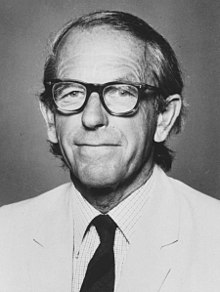Frederick Sanger | |
|---|---|
 | |
| Born | 13 August 1918 Rendcomb, Gloucestershire, England |
| Died | 19 November 2013 (aged 95) |
| Alma mater | St John's College, Cambridge (BA, PhD) |
| Known for |
|
| Spouse | Margaret Joan Howe[4] |
| Awards |
|
| Scientific career | |
| Fields | Biochemistry |
| Institutions | |
| Thesis | The metabolism of the amino acid lysine in the animal body (1943) |
| Doctoral advisor | Albert Neuberger[1] |
| Doctoral students | |
Frederick Sanger OM CH CBE FRS FAA (/ˈsæŋər/; 13 August 1918 – 19 November 2013) was a British biochemist who received the Nobel Prize in Chemistry twice.
He won the 1958 Chemistry Prize for determining the amino acid sequence of insulin and numerous other proteins, demonstrating in the process that each had a unique, definite structure; this was a foundational discovery for the central dogma of molecular biology.
At the newly constructed Laboratory of Molecular Biology in Cambridge, he developed and subsequently refined the first-ever DNA sequencing technique, which vastly expanded the number of feasible experiments in molecular biology and remains in widespread use today. The breakthrough earned him the 1980 Nobel Prize in Chemistry, which he shared with Walter Gilbert and Paul Berg.
He is one of only three people to have won multiple Nobel Prizes in the same category (the others being John Bardeen in physics and Karl Barry Sharpless in chemistry),[5] and one of five persons with two Nobel Prizes.
- ^ Allen, A.K.; Muir, H.M. (2001). "Albert Neuberger. 15 April 1908 – 14 August 1996". Biographical Memoirs of Fellows of the Royal Society. 47: 369–382. doi:10.1098/rsbm.2001.0021. JSTOR 770373. PMID 15124648. S2CID 72943723.
- ^ Brownlee, George G. (2015). "Frederick Sanger CBE CH OM. 13 August 1918 – 19 November 2013". Biographical Memoirs of Fellows of the Royal Society. 61: 437–466. doi:10.1098/rsbm.2015.0013.
- ^ "Seven days: 22–28 November 2013". Nature. 503 (7477): 442–443. 2013. Bibcode:2013Natur.503..442.. doi:10.1038/503442a.
- ^ "The Nobel Prize in Chemistry 1958".
- ^ "Nobel Prize Facts". Nobelprize.org. Retrieved 1 September 2015.